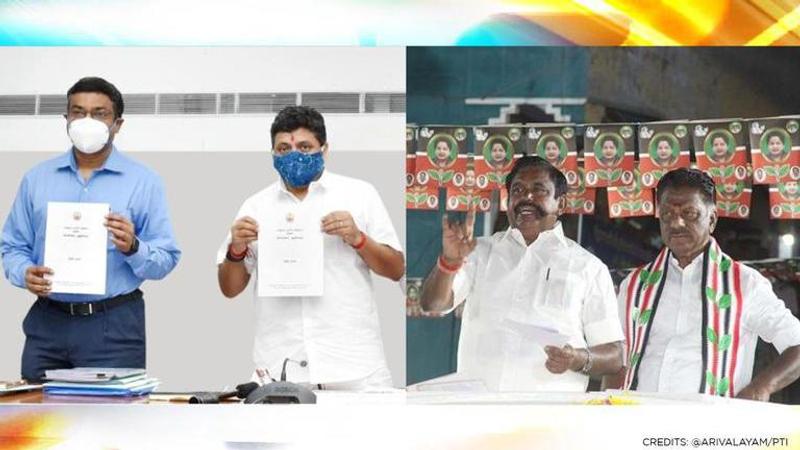Published 14:47 IST, August 9th 2021
Tamil Nadu FM releases 10-yr white paper on govt finances: 'Overall debt at ₹5.7 lakh Cr'
Finance Minister Dr P Thiaga Rajan (PTR) on Monday, revealed that Tamil Nadu's revenue deficit stood at ₹61,320 crore i.e 3.16% of Gross State Domestic Product

Releasing the much-awaited 10-year white paper on the Tamil Nadu government's finances, state finance minister Dr P Thiaga Rajan, on Monday, revealed that Tamil Nadu's revenue deficit stood at ₹61,320 crore or 3.16% of Gross State Domestic Product (GSDP).
The 120-page white paper highlighted the increased public debt, government guarantees, subsidies, debt in PSUs, loans and losses. Refuting any political intent to the paper, Dr P Thiaga Rajan stated that the govt's approach must fundamentally change to break the vicious cycle of increasing debt and interest costs.
Here are the salient points of the white paper:
- The revenue deficit of Tamil Nadu stands at ₹61,320 crore (FY 2020-21) which is, 3.16% of Gross State Domestic Product.
- The fiscal deficit of the State for FY 2020-21 is ₹92,305 crore (4.43% of GSDP). While Tamil Nadu had a deficit of 1.5% in 2017-18 and 1.4% in 2018-19, states like Maharashtra, Gujarat and Karnataka recorded revenue surpluses in both years.
- The public debt is ₹2,63,976 per family in Tamil Nadu, which is 26.69% of GSDP compared to 18.37% in 2007. As per the Interim Budget Estimate of 2021-22, the overall debt of Tamil Nadu will be ₹5,70,189 crore.
- The outstanding government guarantees for FY 2020-21 was ₹91,818 crore, which is the third-highest in the country behind, behind Andhra Pradesh and Telangana.
- The state lost approximately 0.27% GSDP in revenue due to the reduction in revenue from the abolition of vend fee, and reduction of license fee was not fully made up by an increase in VAT on IMFS.
- Tamil Nadu has 6.124% share of the population of the country, but only 4.079% share in the total tax revenue of the country, which is a proportion of 66.607%. This is the third-lowest proportion after Haryana and Maharashtra.
- The Union Government’s levies on petrol have gone up substantially in the past seven years since 2014. These levies were ₹10.39 in May 2014 and by May 2021 these had gone up to ₹32.90 per litre. These cess and surcharges are not shareable with the states.
- Tamil Nadu lost ₹2,577 crore since the previous government failed to conduct local body elections on time.
- The outstanding compensation for 2021-22 (estimated) is ₹20.033 crore.
- Subsidies amounted to 12.65% (₹4,841.80 crore) of RE and 1.48% of GSDP in 2006-07. This has risen fast and reached the level of 27.06% of RE (₹62,338.84 crore) and 3.21% of GSDP in 2020-21. Power subsidy is the highest at 1.10% GSDP among all the other subsidies. Food subsidy amounts to 0.49% of GSDP and transport subsidy is 0.19% of GSDP
- Outstanding government loans have increased from ₹1,578.69 crore in 2006-07 to ₹20,019.98 crore in 2020-21.
- The outstanding debt of TANGEDCO, TANTRANSCO and STUs is ₹ 1,99,572.55 crore put together.
- The average. AGR of GSDP of Tamil Nadu has reduced from 10.15% between 2006 and 2011 to 7.22% between 2016 and 2020.
Suggestions by DMK govt
The Tamil Nadu Finance Minister concluded, "Business-as-usual cannot continue, and our approach must fundamentally change if we are to break out of this vicious cycle of increasing debt and interest costs. On the other hand, this is an opportunity to effect “once in a generation” reforms, many of which should have been undertaken years ago by any responsible Government. We understand that profound structural reforms in many aspects, starting with the Government’s functioning, and expanding to many areas of policy and legislation, will be needed to achieve our ambitious goals".
Updated 14:47 IST, August 9th 2021




